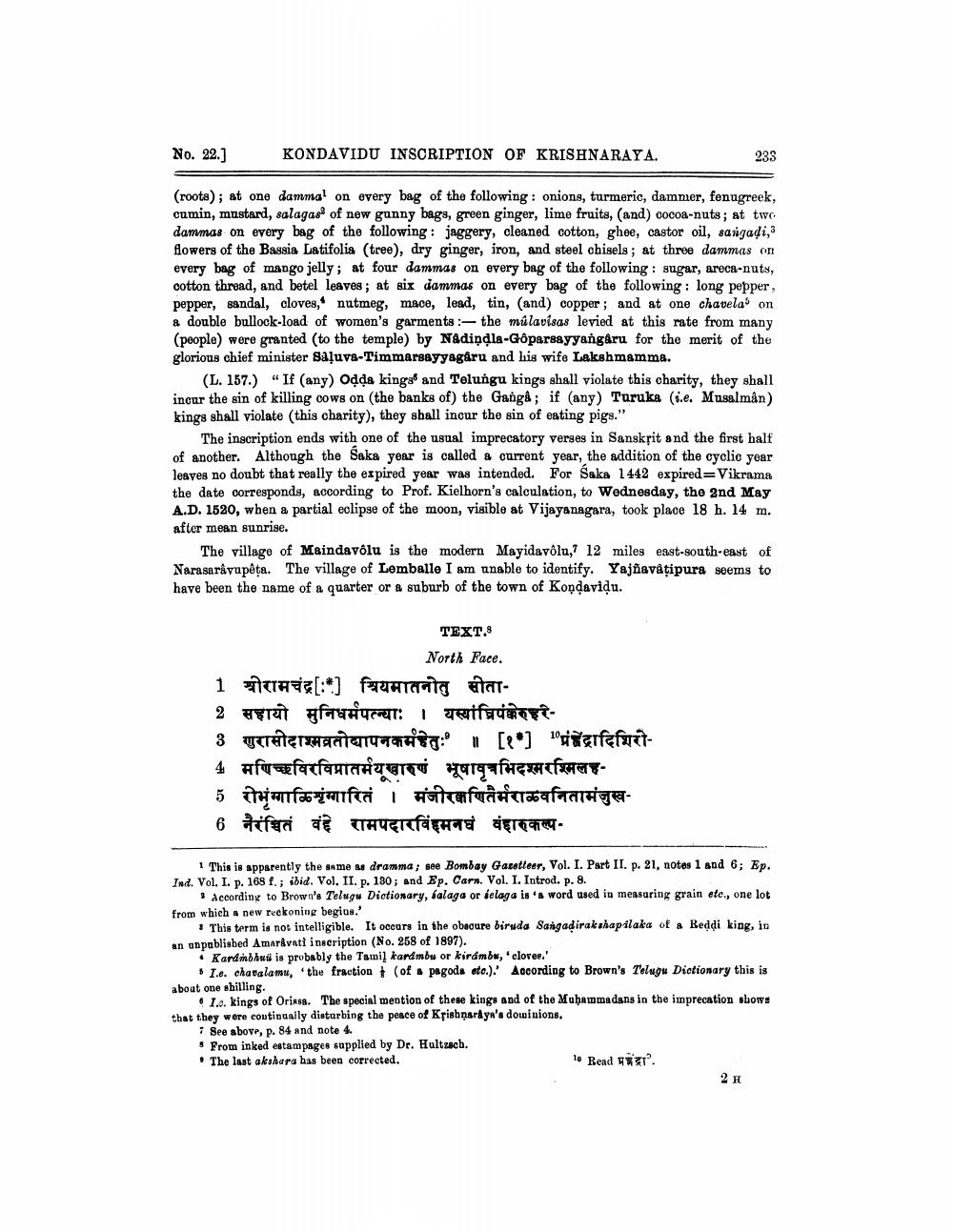________________
No. 22.)
KONDAVIDU INSCRIPTION OF KRISHNARAYA.
233
(roots); at one dammal on every bag of the following: onions, turmeric, dammer, fenugreek, cumin, mustard, salagas of new gunny bags, green ginger, lime fruits, (and) cocoa-nuts; at two dammas on every bag of the following: jaggery, cleaned cotton, ghee, castor oil, sangadi, flowers of the Bassia Latifolia (tree), dry ginger, iron, and steel chisels ; at three dammas on every bag of mango jelly; at four dammas on every bag of the following: sugar, areca-nuts, cotton thread, and betel leaves; at six dammas on every bag of the following : long pepper, pepper, sandal, cloves, nutmeg, mace, lead, tin, (and) copper; and at one chavelas on a double bullock-load of women's garments : - the múlavisas levied at this rate from many (people) were granted (to the temple) by Nadiņdla-Gôparsayyangáru for the merit of the glorious chief minister Saļuve-Timmarsayyagaru and his wife Lakshmamma.
(L. 157.) “If (any) Odda kinga and Telugu kings shall violate this charity, they shall incur the sin of killing cows on the banks of the Gangå; if (any) Turuka (s.e. Musalman) kings shall violate this charity), they shall incur the sin of eating pigs."
The inscription ends with one of the usual imprecatory verses in Sanskrit and the first half of another. Although the Saka year is called a current year, the addition of the cyclic year leaves no doubt that really the expired year was intended. For Saka 1442 expired=Vikrama the date corresponds, according to Prof. Kielhorn's calculation, to Wednesday, the 2nd May A.D. 1520, when a partial eclipse of the moon, visible at Vijayanagara, took place 18 h. 14 m. after mean sunrise.
The village of Maindavôlu is the modern Mayidavôlu, 12 miles east-south-east of Narasarårupêta. The village of Lemballe I am unable to identify. Yajnavåtipura seems to have been the name of a quarter or a suburb of the town of Kondavidu.
TEXT.8
North Face. 1 HTT[:*) Arta bat2 सहायो मुनिधर्मपत्न्याः । यस्यांघ्रिपंकरहरे3 ureterrara197437 [] 10 digifefatt4 मणिच्छविरविप्रातर्मयूखारुणं भूषावृत्रभिदश्मरश्मिलह5 रीभंगाळिशृंगारितं । मंजीरवाणितैर्मराळवनितामंजुख6 नैरंञ्चितं वंद्दे रामपदारविहमनघं वंहारुकल्प
1 This is apparently the same as dramma; see Bombay Gazetteer, Vol. I. Part II. p. 21, notes 1 and 6; Ep. Ind. Vol. I. p. 168 f.; ibid. Vol. II. p. 180; and Ep. Carn. Vol. I. Introd. p. 8.
according to Brown's Telugu Dictionary, falaga or belaga is a word used in measuring grain etc., one lot from which a new reckoning begins.'
This term is not intelligible. It occurs in the obudure biruda Sangadirakshapilaka of a Reddi king, in an unpublished Amaravati inscription (No. 258 of 1897).
• Kardrhbhuid is probably the Tamil karambu or kirámbw, cloree.'
1.e. chavalama, the fraction (of pagods etc.).' According to Brown's Telugu Dictionary this is about one shilling.
1.0. kings of Orinss. The special mention of these kings and of the Muhammadans in the imprecation shows that they were continually disturbing the peace of Krishnaraya's dominions.
· See above, p. 84 and note 4. . From inked estampages supplied by Dr. Hultzach. . The last akshara has been corrected.
10 Read 31.
2




